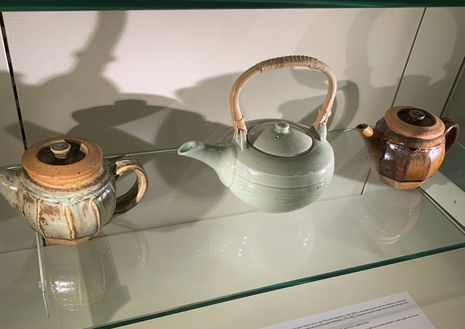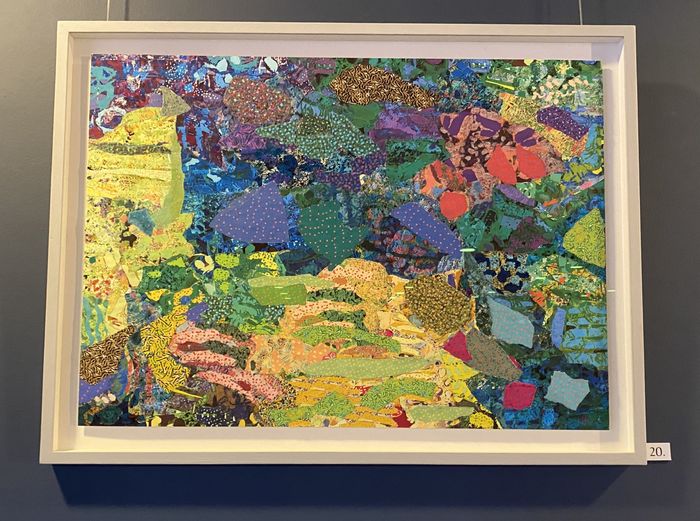The Bell Collection at Clare Hall showcases the organic beauty of pottery
Senior Arts Editor Emily Lawson-Todd reviews Clare Hall’s latest exhibition, finding it to be a celebration of the relationship between fashionable and functional

I begin this article with a disclaimer: I know very little about pottery. In fact, the closest I get to being a collector of the stuff is by occasionally being gifted stolen college crockery from friends at other colleges. However, there is something so interesting about pottering as an art form, the way it occupies the space between fine art and functional object, unique piece and mass-produced commodity, that compelled me to visit Clare Hall to look at their new exhibition, The Bell Collection of British Studio Pottery 1920–1980.
The collection is a new instalment nestled in the porters’ lodge of Clare Hall, composed of roughly 300 pieces of pottery gifted to the College by Professor G.H. Bell and Mrs K.M. Bell, associates of the College. It is a collection 60 years in the making, with pieces spanning across most of the 20th century, and featuring a variety of styles, from mass-produced bowls to Japanese tea seats, which ultimately proved to be a very risky collection to view for someone as clumsy as me.
Once I had managed to calm my initial nerves that I would somehow manage to wipe out nearly a century worth of valuable pottery due to a lack of spatial awareness, and having made sure my shoelaces were double-tied, I was finally able to start appreciating the sheer range of craft on display. Labels told me whether a piece was hand-thrown, salt-glazed, or crafted in an artisans workshop, drawing attention to the fantastic amount of human effort behind the creation of a single piece of pottery. Often, it is far too easy to forget that the objects we hold every day – mugs, pots, plates and bowls – often have a real artisanal background to them. Here, this was brought to the forefront to spectacular effect.
“There was a real sense that visually appealing and tactile need not be polar opposites”
The juxtaposition between slightly more practical pieces and those of the “for display only” variety made for an interesting investigation into the way that we interact with objects, crafting a conversation about the relationship between the practical and the aesthetic. Yet sometimes, these two collided. I was struck when looking at several of the Japanese tea sets on display at just how beautiful practical objects can be, and the artistic nature behind the act of drinking tea. Through the beautiful, organic shape of the teapot, there was a real sense that visually appealing and tactile need not be polar opposites. Richard Batterham’s dark glazed teapots were the perfect blend between beautiful and functional, and provided stunning contrast with the delicate leaf-impressed work of Bernard Leach; the composition struck a balance between fragility and functionality which really spoke to me about the nature of pottery.
“A reminder to not overlook that which we take for granted on a daily basis”
Throughout my entire viewing of the collection, I was struck by how organic everything was. Aside from the odd flash of hot pink or electric cyan, most of the collection was composed of muted, earthy tones of greens, grey-blues and browns, with the occasional deep burgundy thrown in. This worked to the collection’s benefit, helping to tie in pottery from all different sorts of makers, backgrounds, and uses, while all providing the viewer with a reminder of the organic roots of pottery. Bamboo and cane handles on teapots also helped achieve this effect, drawing in the various organic materials that surround us into one object, serving as a reminder to not overlook that which we take for granted on a daily basis. Perhaps then, this collection does suit its location in the porters’ lodge – which initially struck me as a strange space to put a large number of breakable objects - as I suppose both pots and plodges are things or places we tend to overlook in our everyday existences.
All in all, despite knowing very little about pottery, I left the collection with a new mindset (and with a grand total of zero teapots broken). Perhaps I still didn’t really know what difference something being “salt-glazed” meant to the finish of a decorative plate, but from viewing the collection, I learned a much more valuable lesson: beauty is all around us, even in the things that we are inclined to overlook. The next time I pick up a plate (stolen from brunch at another college or otherwise), I’ll consider how it stands within a long and impressive artistic tradition.
The exhibition is available to view with free admission daily from 10am to 5pm.
 News / SU stops offering student discounts8 January 2026
News / SU stops offering student discounts8 January 2026 Comment / Plastic pubs: the problem with Cambridge alehouses 5 January 2026
Comment / Plastic pubs: the problem with Cambridge alehouses 5 January 2026 Theatre / Camdram publicity needs aquickcamfab11 January 2026
Theatre / Camdram publicity needs aquickcamfab11 January 2026 News / Cambridge academic condemns US operation against Maduro as ‘clearly internationally unlawful’10 January 2026
News / Cambridge academic condemns US operation against Maduro as ‘clearly internationally unlawful’10 January 2026 Comment / What happened to men at Cambridge?31 December 2025
Comment / What happened to men at Cambridge?31 December 2025









